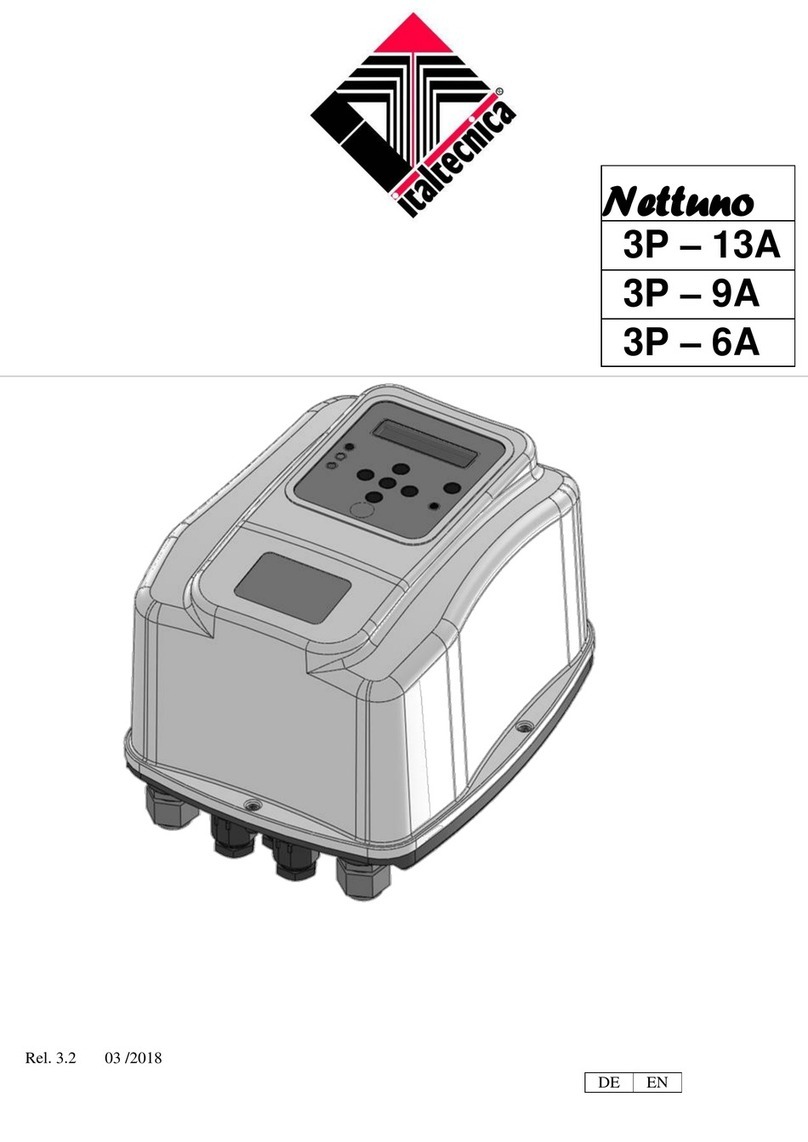Nominal motor frequency: depending on which motor is used, it is possible to select a maximum nominal
output frequency from the inverter (50 or 60 Hz). Caution: an incorrect selection of the maximum frequency
may cause damage to the pump; consult the manufacturer's technical data carefully.
Switching frequency: set the frequency of inverter switching. The selectable values are 3, 5 and 10 kHz.
Higher switching frequency values may reduce the noise of the inverter and allow a more fluid regulation of the
motor but may cause increased temperatures in the electronic board, an increase in electromagnetic disturbances
and potential damage to the electric motor (especially with long cables). Low switching frequency values are
recommended for medium-large pumps, where there is a long distance between the inverter and motor or high
ambient temperatures.
Frequency correction: this parameter enables entry of a deviation, positive or negative, of the maximum
requency compared to the set nominal value. It may be useful to set a negative deviation (up to ±5Hz) where a
limit to the maximum power of the electric pump is wanted and to avoid possible overload. A positive increase
(up to +5Hz) may instead be necessary when a slightly higher electric pump performance is needed. While no
particular precautions exist in lowering the maximum frequency, its increase must be carefully evaluated after having consulted the
manufacturer of the electric pump and taking into consideration the maximum current supported by the inverter.
Soft-Start (progressive start-up): This screen enables the user to activate or deactivate "soft-start" function.
When this function is active the pump starts up progressively; by contrast, the start-up is always at maximum
revs for a period of 1 second before the adjustment of revs begins.
Pump type: set the type of the pump connected to Sirio, single phase with starting capacitor (1 X 230V) or
three-phase with delta connection (3 X 230V).
Flow sensor: this activates or deactivates operation of the integrated flow switch. The factory setting of the
flow switch is active, so that the pump will stop when the valves close, detecting a zeroing of the flow through
the inverter. The same principle is used for the protection against dry-running. In any case, conditions may
occur (for example, the use of not perfectly clean water) which could impair correct operation of the flow
switch preventing the pump from stopping correctly. In these conditions, it is possible to deactivate the flow
switch and operate the Sirio exclusively on the basis of pressure and frequency information. In this case it is essential to correctly regulate
the parameters of the stop frequency and dry-running pressure for efficient operation of the inverter. Furthermore, when the flow switch is
deactivated, it is necessary to install an expansion tank immediately after the Sirio to help regulate the pressure in the stop phase and avoid
continuous restarts of the pump, taking care to periodically check the pre-load values.
Command origin: selects the command source. If the parameter is set to pressure, the operation is regulated
automatically based on the system pressure. Otherwise, if set to manual mode, it is possible to manually
command start-up, stop and the speed of the electric pump directly via the keyboard. Caution: in manual mode,
the dry-running and pressure limitation protections are not active. This mode should only be used temporarily
and under the direct control of a person. Pay maximum attention during these operations!
Auxiliary contact: use this parameter to select the function to be associated with the auxiliary contact; the
settable values are as follows:
³-!´WKHDX[LOLDU\FRQWDFWis used for the connection of two Sirio devices in a twin pressurisation unit (factory
settings)
³-³WKHDX[LOLDU\FRQWDFWLVXVHGWRUHPRWHFRQWUROWKHVWDUWVWRSRIWKHPRWRUSXPS
³;´WKHDX[LOLDU\FRQWDFWLVXVHGWRFRQWURODVHFRQGSUHVVXUHVHW-point (Pmax2).
Input function on the I/O board: determines the function associated with the digital input of the auxiliary I/O
board (available on request).
The settable values are:
³2))³input disabled
³(55´error signal: on closure of the auxiliary input, the pump will immediately shut down and "External error" will appear on the screen.
Use this function if it is necessary to stop the inverter due to an external error.
³-³the auxiliary input is used for remote control of start-up and shut-down of the electric pump; if the same setting is also active for the
parameter "Aux. Con", it is necessary to close both contacts to start the motor (AND logic)
³;´the auxiliary input is used to control a second pressure set-point (Pmax2); the auxiliary input is used to control a second pressure set-
point (maxP2); if the same setting is also active for the parameter "Aux. Con", it is necessary to close one of the two contacts to control the
second set-point (OR logic).






























